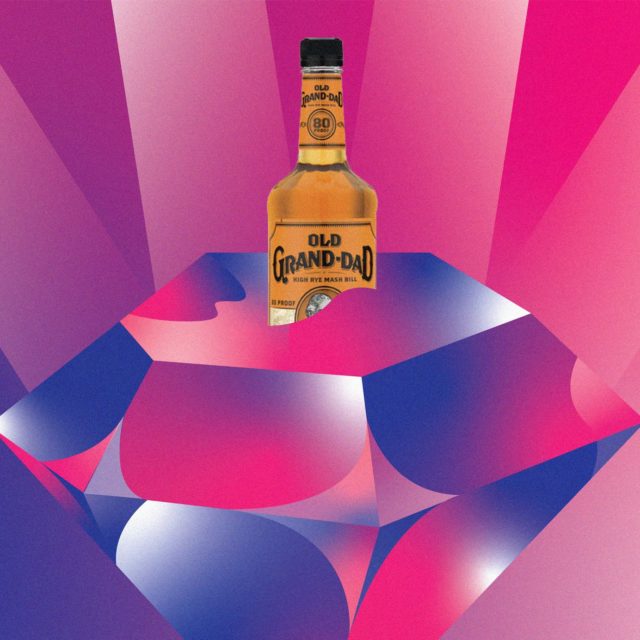Along with bargains, hidden gems remain a scarcity in the bourbon hunting world. But while many cult favorites have seen their prices double and even quadruple in recent years, one brand has remained firmly rooted to the bottom shelf at the liquor store. This, despite the fact it is revered by both bartenders and whiskey collectors, and uses the exact same mash bill as a more expensive, better-known bourbon.
The brand in question is by no means unknown to seasoned whiskey drinkers, but it is little known outside of collector and bartending circles. That, many say, is a great shame — as long as its prices don’t skyrocket — because this bourbon not only offers great value for money, it also serves an insightful intro to the world of high-rye mash bills, and arrives with more than a century of history.
Old Grand-Dad occupies that dwindling, charming territory of providing great juice at a fair price (less than $30 per bottle across the country). In a world of surging secondary market prices and “unicorn” bottles, OGD — as it’s known by aficionados — remains affordable and widely available. Rather than a trophy to stick on a shelf, this is a bourbon you buy to drink, comfortable in the knowledge that another kitschy bottle, complete with gold and orange label, and cheap, screw-on plastic cap, will be waiting for you when your supplies dwindle. For some, that may make it a unicorn in its very own right.
Who Was “Old Grand-Dad?”
First produced in 1882, Old Grand-Dad was founded by Raymond B. Hayden, who named the brand after his grandfather, Basil Hayden Sr. A well-known distiller in his own right. Hayden Sr.’s name now adorns the label of another famous bourbon brand, but his portrait continues to look on from the label of OGD with a friendly smile.
During its more than 100-year history, Old Grand-Dad has seen several ownership changes and has been produced at multiple distilleries. Throughout that time, the brand has been continually available to American drinkers.
Old Grand-Dad survived the “dry” era of Prohibition as one of a handful of brands doctors were allowed to prescribe as a medicinal whiskey. Physicians would charge around $3 per pint for ailments such as high blood pressure, pneumonia, and digestive issues. As an old Kentucky adage goes, and Old Grand-Dad proclaims on its modern-day website, “It was a popular time to be sick.”
Today, Old Grand-Dad is owned by Beam Suntory and arrives at three separate proofs: 80, 100, and 114. Of the three, OGD enthusiasts overwhelmingly favor the 100 proof “bonded” version, which is aged at least four years in a federally bonded warehouse, and distilled in one season by one distillery, in compliance with the Bottled In Bond Act of 1897. Old Grand-Dad is also notable for being a high-rye bourbon, containing around 27 percent of the grain in its mash bill. (Basil Hayden Sr. was renowned for including a higher amount of rye in his mash bills than other brands and likely passed on his recipe to his grandson.)
Bottom Lines and Backbone
Price is only part of the appeal when it comes to Old Grand-Dad. But for bartenders, it makes stocking OGD a no-brainer. “It’s phenomenal for the price point,” says Josh Gandee, co-founder of Columbus-based consulting agency Historic Revelry and beverage director at Watershed Kitchen + Bar. “As a bar manager that’s something you want to focus on first — your bottom line.”
Beyond its affordable appeal, Gandee praises Old Grand-Dad’s versatility. It’s perfect for “down and brown” spirit-forward cocktails, he says, like the Manhattan and the Remember the Maine, a Manhattan-Sazerac hybrid that includes Cherry Heering liqueur and absinthe. OGD also delivers for those who prefer their brown spirits neat, Gandee says. “You get really great flavors from it every time — nice caramels and vanillas — and with it being bonded, you get that backbone as well,” he adds.
Los Angeles and Atlanta-based Samara Rivers, co-founder of Black Bourbon Society (BBS), agrees, adding, “Folks who do know about OGD know it’s great juice, they also know that Old Grand-Dad is essentially the same whiskey that’s in Basil Hayden’s.” Another high-rye release, though slightly lower proof, Basil Hayden’s is also owned and produced by Beam Suntory but retails for up to $20 more per bottle than Old Grand-Dad.
A Bourbon Fit for Presidents and Whiskey Collectors
For Kentucky-based bourbon educator and author Susan Reigler, Old Grand-Dad offers a great introduction to high-rye bourbons. When she hosts educational tastings, Reigler serves it alongside similarly priced bourbons with more traditional mash bills, such as Old Forester, as well as those with a high wheat content, like Larceny. That way, those beginning their bourbon journeys can fully appreciate what each grain adds to the spirit, she says.
Reigler also has a soft spot for OGD because of its historical value. “It was Harry Truman’s bourbon,” she explains. “Every morning for breakfast he would have a couple of strips of bacon, toast, a glass of milk, coffee, an egg or two, and a shot of Old Grand-Dad. Then he would go for a walk along the Potomac, come back for a massage, and then run the country.”
Old Grand-Dad may have swapped its place on the presidential breakfast table for the bottom shelf of liquor stores. But for collectors and bartenders, that only adds to the appeal. “Real whiskey collectors, they have all these rare, limited-release bottles — the high-end stuff — and they also have OGD,” says BBS’s Rivers. “I think that says it all, really.”
